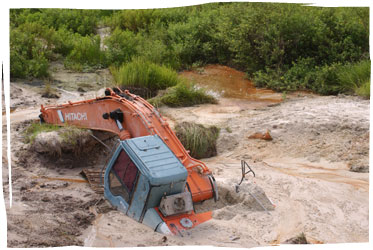Clay Settling Areas

The large amounts of clay that are displaced from strip mining operations are accumulated by phosphate companies and left to settle, causing huge changes in the way that water moves through a former mine site.
When phosphate is mined, it comes out of the ground mixed with sand and clay that is separated in a process known as beneficiation. In order to pipe the ore to beneficiation plants, it is mixed with fresh water until it becomes slurry. The leftovers of the beneficiation process are sand tailings and a slimy mix of water and clay. The clays are dumped into giant holding systems known as clay settling areas. As the water comes to the top, it is skimmed and reused in beneficiation. After a site is mined, approximately 40 percent of the mined area is comprised of clay settling areas.
The clay-water mixture being pumped into a Clay Settling Area (CSA). Large adjustable weirs allow water to be skimmed off but the consolidation of the clays take decades.
While strip mined land must be reclaimed, the clay settling areas remain barren islands of waste with little ecological value. Moreover, because the areas are clay, they are much less permeable than Florida's natural sandy soil. That means rainfall cannot seep through the clay bottom to recharge the aquifer. Since 40 percent of the mine site becomes clay settling area, they have the effect of changing surface and underground water flows–permanently.
Developing the land is risky because consolidation of the clay settling areas typically takes decades. The ground is soft and sinking.
And, the environmental damage resulting from accidental spills from a clay settling area can be devastating.
September, 2004
A dike at the top of a 100-foot-high gypsum stack in Riverview, Florida, broke after waves from Hurricane Frances battered the southwest corner of the pile. The rupture sent 60 million gallons of acidic liquid into Archie Creek a tributary of the Hillsborough River.
November, 1994
A dam failure at the Hopewell Mine in Hillsborough County caused nearly 500 million gallons of water to spill from a clay settling area. The water spilled into nearby wetlands and the Alafia River, and flooded parts of Keysville.
October, 1994
More than 132 million gallons of water from a clay settling area spilled into a tributary of Payne's Creek after a dam failed at the site. A 1945 dam break released phosphate clays into the Peace River killing thousands of game fish.
December, 1971
A retention pond release spilled a billion gallons of clay slime into Whidden Creek and turned Charlotte Harbor a dark, muddy brown. The cost of that cleanup reached $6 million.
March, 1967
A rupture of a retention dike near Fort Meade, Florida, released 2 million gallons of phosphate waste into the Peace River. The accident killed a million fish and didn't subside until two years later.